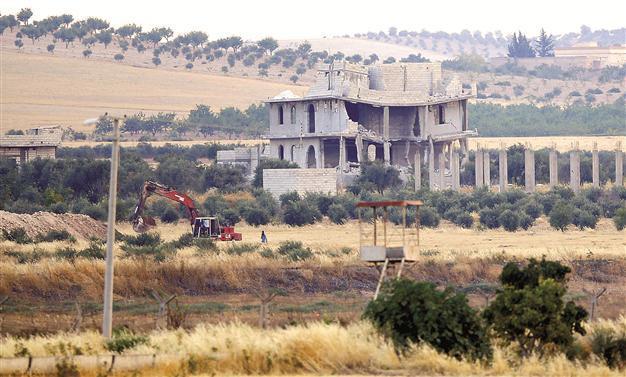US uses armed drones against ISIL in Syria
WASHINGTON - The Associated Press

A masked man stands next to an excavator as it digs trenches in the Islamic State-held Syrian town of Jarablus as seen from the Turkish border town of Karkamış. Reuters Photo
The U.S. military is expanding its combat role in Syria in defense of coalition-backed rebels, conducting armed drone missions into Syria from the İncirlik air base in Turkey.
The first armed drone missions out of Turkey began last weekend, and the military is planning to add manned aircraft flights from there, U.S. officials have said.
As of Aug. 3, none of the drones had launched airstrikes, but Navy Capt. Jeff Davis, a Pentagon spokesman, said they may begin conducting strikes soon. He said the U.S. will also likely fly search and rescue missions from the base in Turkey.
The use of the İncirlik base comes as the U.S. began launching airstrikes to defend U.S.-backed Syrian rebels when they come under fire from forces other than Islamic State of Iraq and the Levant (ISIL) militants.
Davis said the U.S. used strikes to defend rebels that were coming under attack by the al-Qaeda-affiliated al-Nusra Front for the first time on July 31.
Under current guidelines, U.S. forces can only conduct offensive missions against ISIL, and cannot go after other groups such as President Bashar al-Assad’s forces, largely due to worries it would set off war with Syria.
However, U.S. officials in recent weeks have walked a careful line, arguing that they have an obligation to defend the Syrian rebels that have been trained by the U.S. to help battle ISIL. Under new rules, the U.S. can defend the rebels if they come under fire from government forces or any other group, such as the al-Nusra Front. American forces still can’t launch offensive missions against those other groups.
“I am pleased that the administration has finally decided to provide additional military support to the Syrian forces the Department of Defense is training and equipping to counter ISIL in northern Syria,” said Sen. John McCain. But the Arizona Republican expressed concern about “a policy of gradual escalation that has plagued U.S. efforts since the start of the conflict in Syria.”
Davis declined to provide details on the new rules of engagement for the military, including what conditions have to exist before the U.S. can defend the Syrian rebels, and whether strikes would be limited to instances when only U.S.-trained rebels are at risk, or if other rebels who have not yet been trained can also be defended.
The shift in military strategy had been pushed by members of Congress who argued that the U.S. could not train the rebels and then send them into battle against ISIL with no back-up. Others, however, warned that many of the rebel groups are primarily focused on overturning the Syrian government, and that supporting them would put the U.S. into a messy war with a sovereign nation that has sophisticated air defenses.
Al-Assad last month acknowledged that his troops have lost territory to rebel forces and were running short on manpower, but he vowed that he would win the long-running civil war.
Until now, the U.S.-backed campaign against ISIL has aligned with al-Assad’s interests, because he also wants to defeat the insurgents. As such, his government forces have not interfered with any of the coalition aircraft launching strikes against ISIL. But the plan to now back the moderate rebels if they come under fire by regime forces could increase that risk and fuel opposition from other countries.
Russian Foreign Minister Sergei Lavrov, speaking to reporters after a meeting with Secretary of State John Kerry and Saudi Foreign Minister Adel al-Jubeir, criticized U.S.-led efforts to train members of the Syrian opposition to fight inside the country, and called for an end to “foreign intervention” in the Syria crisis.
